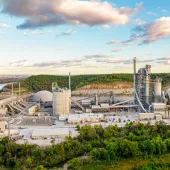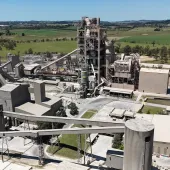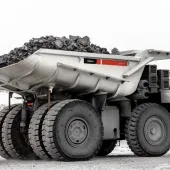Kingfisher Industrial solutions for cement manufacture
Cement production is estimated to emit 5-6 percent of the total man-made greenhouse gases. Some of the greenhouse emissions from conventional cement production come from using fossil fuels to heat up limestone to the high 1,500 degree C temperatures required by the process, so it is unsurprising that alternative fuelling methods are now being thoroughly exploited. The use of alternative fuels in European cement kilns is now estimated to be equivalent to 2.5 million tonnes of coal a year.
The use of alternative fuels is considered to represent the Best Available Techniques (BAT) for all cement manufacturers. Many UK cement producers have signed a climate change levy agreement with the UK government. The agreement sets a target of both kiln fuel and electricity, which will result in a substantial reduction in carbon dioxide emissions.
Alternative fuels used in cement manufacturing have differing characteristics such as SRM (secondary raw materials), RDF (refuse-derived fuel), SRF (solid recovered fuel) and PSP (pelletized/processed sewage pellets) when compared to more conventional fuels. Switching from conventional fuels to alternative fuels presents several challenges that must be addressed in order to achieve successful application. Poor heat distribution, unstable pre-calciner operation, blockages in the pre-heater cyclones, build-ups in the kiln riser ducts, higher SO2, NOX and CO2 emissions, dusty kilns and excessive wear in pipe work, valves, burners, chutes and cyclones are just some of the challenges.
The same problems arise in the increasing number of industries that are replacing fossil fuels with renewable materials or supplementing fuel streams with mixed waste and recyclate in order to achieve carbon offsetting. Managing biomass and mixed media can take its toll on processing equipment unless it has been designed or adapted for handling products with varying characteristics that create excessive abrasion and corrosion.
Kingfisher Industrial, experts in the protection of plant and equipment for handling aggressive materials, can help cement plant operators ensure that their fuel handling equipment is able to withstand the rigours of conveying mixed media by offering a tailored solution to each situation to counter the detrimental effects of processing abrasive minerals and media.
The main technique used is to line the handling equipment with an appropriate hardwearing lining system, matched to the materials being conveyed. For any given project Kingfisher will assess the situation, recommend solutions based on the type of media mix, design and manufacture plant for conveying, storing and processing the fuel, install and commission it. This will ensure that fuel-handling equipment is reliable, wear and damage resistant over an extended working life (which is often measured in many years of service).
By implementing best engineering practice, Kingfisher say that key plant and equipment can operate on a continual basis and lead to increased efficiencies and profitability. The company has considerable expertize in combating wear and corrosion within cement and other heavy industrial plants and has frequently extended the service life of key processing equipment by utilising its range of protection systems.
Kingfisher work with a number of preferred materials suppliers to offer an unbiased approach to solving the problems experienced when handling bulk solid materials and allow it to offer the best solution or solutions for any given situation.
Despite manufacturers’ many claims to offer the ultimate material in the ‘fight against wear’, success levels can vary enormously, so there is a need to analysis each individual set of circumstances. Sometimes the wear-resistant properties of one material type may be in excess of requirements and conversely, those same properties may under-perform in a different application, putting the material’s suitability in either case under question. Careful assessment is a key requirement for success.
Technically speaking three familiar material groups are most common for wear protection duties - ceramic, metallic and polymer.
Ceramics are available in their long-established cast form and as state-of-the-art pressed products. They are used in a wide range of situations: high alumina, fused cast basalt, silicon carbide and fused corundum.
Metallic solutions are usually based on hardened versions of common metals and are suitable for a wide range of applications. They have been in use for many years and are favoured by many users. Specialist metal alternatives are also available and can provide the optimum outcome to unusual situations, such as high chrome, Ni–hard, manganese castings and chrome carbide overlay plate.
Polymers, such as rubber, often work in a counter-intuitive way, having the ability to absorb the shock of impact and dispel the damaging forces. Other polymers, such as polyethylene, with its very low coefficient of friction, encourage the material to glide over it as opposed to scouring the surface, thus reducing the effects of friction or sliding-induced abrasion. Polymers tend to be lightweight, flexible and relatively easy to apply.
The use of polymers to protect equipment where extreme impact prior to crushing is evident benefit from being lined with hard rubber liners and likewise the difficulties associated with the storage of coal and cement are eliminated due to the low coefficient of friction that polyethylene liners offer in assisting discharge.
In all of these cases, the cement industry can achieve significant benefits when employing wear-resistant linings and wear-protection systems. New or existing equipment can be retrofitted with a protection system to add to its current asset value.
Kingfisher have expertise with all three material groups and tailor solutions to each specific situation. Before making recommendations Kingfisher undertake a full in-depth analysis of a plant’s operational criteria and identify a system that is fit-for-purpose to meet the many requirements of the end user. Criteria that are reviewed in the decision-making process include the type of material being conveyed, size and shape, volume and velocity, operating temperature, together with the budget constraints versus the operating life cycle required.
Kingfisher have already installed their wear-resistant lining solutions within a number of plants that use the different types of alternative fuels. Referring to a project carried out at a cement plant in Derbyshire, the manufacturing plant has been working with SRF since 2009. During the installation of the SRF system, Kingfisher were approached by a process engineering company to supply pipes lined with K-BAS cast basalt wear-resistant lining systems. After a couple of months of operation the plant was advised to upgrade their conveying bends to K-ALOX ceramic wear systems instead.
John Connolly, managing director of Kingfisher Industrial, said: 'Due to the erosive nature of the material, the K-BAS lining system did not meet the life expectancy of the system. As part of our after-sales service our engineers identified the problem and advised the customer to upgrade the lining system to an alternative material type.'
Adding to the process Kingfisher have engineered bends with a removable wear back that is fitted with their own Abralarm wear-detection system. The system comprises of a low-voltage electrical indicator that is integrated between the lining system and steel casing, when the lining system is breached it will sever the induction loop and send a signal through to the SCADA/PLC system located in the customer's central control room which enables the operation team to plan for replacements.
Kingfisher were also approached by the plant engineers to provide a suitable lining option for a silo used within the SRF process. The problems encountered by the plant included 50-80mm bed of excessive material which was recovered at the bottom of the silo after every shutdown, usually the silo would be reasonably full hence the lining solution provided must be able to endure high impact without causing any issues.
During the site visit carried out by Kingfisher’s sales manager he commented: “The largest piece of material entering the silo was measured at 150mm x 20mm x 3mm thick. As material degrades in the silo, the moisture increases and the inside of the structure becomes saturated, which in turn creates a dew point, and excessive corrosion becomes a major problem if left untreated.
The solution suggested was Kingfisher's polymer-based epoxy-resin spray application. The characteristics offer a tough, impermeable barrier suitable for steel and concrete surfaces. Providing resistance to most chemical agents, particularly strong acids (including 98% sulphuric acid) alkaline, and many solvents, the low-odour system forms a very hard gloss finish which is evident on the surface of the plant and equipment.
The materials that make up typical mixed media and biomass fuels can create many problems due to the size, shape, density and tonnages that are handled. For another international cement manufacturer who has used alternative fuels since 1992 by successfully implementing the use of recycled tyres, meat and bone meal (MBM) and SRF, Kingfisher have supplied pipe work for the existing pilot plant, the pipe work supplied was lined with the K-BAS cast basalt lining systems.
Kingfisher have also supplied similar wear-resistant pipework systems used at one of largest sludge drying centres in Europe. The plant processes sludge from hundreds of wastewater treatment plants into processed sludge pellets. Kingfisher solutions will also optimize plant layout for clear flow lines without bottlenecks or other points of weakness. Applications such as the installation of low-friction linings systems within the fuel reception hoppers can also eliminate the need for mechanical aids or personnel having to gain access in order to clear blockages. According to Kingfisher, their built or adapted systems will generally need less maintenance, as the protective systems reduce the need to continually undertake repair work.
As well as handling the fuel, Kingfisher technologies can also be applied to the actual process of cement manufacture, from the quarried limestone to the bagged despatch point. This involves a multitude of activities with each operation depending on the success of the previous stage. Kingfisher say they can solve the problems experienced with mineral excavation, blending of clay and chalk, firing, cooling and storage of clinker as well as the milling and conveying of cement. Equipment such as front-loading buckets, crushing equipment and reception hoppers have seen extended service life through the use of protection systems such as chromium carbide-clad plate or manganese steel castings.









